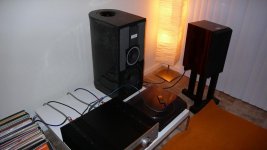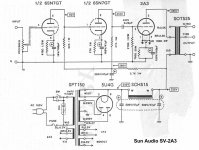Hi,
I built a carbon fiber laminated MDF loudspeaker using Raven R2-PHL 1120 and PHL 3003 drivers. The active crossover is an audio-kit crossover at 300Hz and 2.5Khz
http://www.audio-kits.com/catalog/item/4071180/3884480.htm
I build 3 channels of Sun Audio sv2a3 based SET (using a single power supply) to power one single speaker for testing. This is a simple 6sn7 cascade - 2a3 design. The sound is good and I am looking for suggestions on how to optimize my second build. Based on the initial listening, I am thinking of making the following modifications:
a) Separate power supplies for the bass channels. The current single power supplies sound insufficient during heavy music passages.
b) Using 15H/10H chokes instead of 5H. + 100uf filter capacitor for bass channel.
c) Use JJ 2a3-40W tube for bass, bias at 260v, 80mA. I feel I needed more power for bass during initial listening
d) Hashimoto Output Transformer H203-S for Highs/Mid and Lundahl LL1623 for bass. I have these.
e) Using DC heated supplies (IC regulated) for 6sn7 and 2a3 only for the bass channel. If the results is good, I might use this for the mid/highs too. Hum is currently at 4-5mV measured at woofer. 2mV at Twt and Mids. Should I use DC heated supplies for mid/highs too?
e) changing the crossover points to 400 Hz and 4KHz. Somehow, I feel that the Raven R-2 sonic signature is too different to the PHL and a higher crossover point may help the sound. Is this a good choice? Or I should drop the Raven and use a dome tweeter like Seas Millenium?
This is my first diy tube amplifier attempt and 2nd DIY loudspeaker (The first Pine wood based speaker resonates so I dropped it ) so any suggestions to a newcomer to this hobby are appreciated!
so I dropped it ) so any suggestions to a newcomer to this hobby are appreciated!
Thanks!
Marcus Tan
I built a carbon fiber laminated MDF loudspeaker using Raven R2-PHL 1120 and PHL 3003 drivers. The active crossover is an audio-kit crossover at 300Hz and 2.5Khz
http://www.audio-kits.com/catalog/item/4071180/3884480.htm
I build 3 channels of Sun Audio sv2a3 based SET (using a single power supply) to power one single speaker for testing. This is a simple 6sn7 cascade - 2a3 design. The sound is good and I am looking for suggestions on how to optimize my second build. Based on the initial listening, I am thinking of making the following modifications:
a) Separate power supplies for the bass channels. The current single power supplies sound insufficient during heavy music passages.
b) Using 15H/10H chokes instead of 5H. + 100uf filter capacitor for bass channel.
c) Use JJ 2a3-40W tube for bass, bias at 260v, 80mA. I feel I needed more power for bass during initial listening
d) Hashimoto Output Transformer H203-S for Highs/Mid and Lundahl LL1623 for bass. I have these.
e) Using DC heated supplies (IC regulated) for 6sn7 and 2a3 only for the bass channel. If the results is good, I might use this for the mid/highs too. Hum is currently at 4-5mV measured at woofer. 2mV at Twt and Mids. Should I use DC heated supplies for mid/highs too?
e) changing the crossover points to 400 Hz and 4KHz. Somehow, I feel that the Raven R-2 sonic signature is too different to the PHL and a higher crossover point may help the sound. Is this a good choice? Or I should drop the Raven and use a dome tweeter like Seas Millenium?
This is my first diy tube amplifier attempt and 2nd DIY loudspeaker (The first Pine wood based speaker resonates
Thanks!
Marcus Tan
Attachments
Almost certainly the best thing you can do is to optimize your crossover. I bought a Behringer DCX2496 purely to use as a test bed to find out what crossover is needed (I can dial in anything I like in seconds). When my new loudspeakers are built, I will use the Behringer to find out what is the optimum crossover, then build it in analogue. To do all this properly, you're going to need a loudspeaker measurement system. I use LAUD because I bought it years ago, but there are lots of more recent soundcard-based measurement systems.
marcutan said:I agree, its a hassle to re-solder the PCB board to test new operating point.
It took me five goes and all day to get my last loudspeakers sorted doing it analogue on breadboard. I could have done it in half an hour with the Behringer.
I struggled for 10 mins to desolder a cap from the XO PCB broad and gave up. Just purchased an Ashly crossover.
What's the best way to get good bass from 2a3? Is there any tweaks I can do to the Sun Audio schematic to get punchier tight bass?
My woofer is the PHL 3003.
What's the best way to get good bass from 2a3? Is there any tweaks I can do to the Sun Audio schematic to get punchier tight bass?
My woofer is the PHL 3003.
Attachments
For cathode bias, is it ok to increase the bypass capacitor from 100uf to 200uf? The lundahl ll1623 transformer has a 1.6k, 3k and 5k tap, I will use the 3k tap as its closest to your suggestion. Might play around with 1.6k tap to test out the difference.
Instead of using a 300b for bass, I am going for a JJ2a3-40, which is fundamentally a 300b with 2.5V filaments. However, I decided to bias it at 250v, 80mA instead of the traditional 300b bias point (350v, 75mA) as the graphs/specs shows that it is more linear at around 250v. I am using a JJ2a3 to have a more sonically balanced sound; relative to the 2a3 mid/highs.
I did consider push-pull too, but I needed to reduce costs.....building 6 channels of 2a3 SET to tri-amp has been expensive enough......I tried solid state amplification and didn't like the results (even with a tube pre amp at the front).
Thanks!
Instead of using a 300b for bass, I am going for a JJ2a3-40, which is fundamentally a 300b with 2.5V filaments. However, I decided to bias it at 250v, 80mA instead of the traditional 300b bias point (350v, 75mA) as the graphs/specs shows that it is more linear at around 250v. I am using a JJ2a3 to have a more sonically balanced sound; relative to the 2a3 mid/highs.
I did consider push-pull too, but I needed to reduce costs.....building 6 channels of 2a3 SET to tri-amp has been expensive enough......I tried solid state amplification and didn't like the results (even with a tube pre amp at the front).
Thanks!
to get the good bass from 2A3
try with Lp of output transformer
>=22H, Ck=22uF-33uF (as higher Lp, the value of Ck decreasing...)
and lower value of C at Vb side at OT of about 16uF to 22uF...
-3db around 8Hz and flat, no peek
on the other side of BW find the Cdyn fot 2A3 in the circuit...
for the -3db at 131KHz it is about 16.5Kohm og Req of driver/input tube.
for instance 12ay7 in parallel...
or maybe Loftin-White config.
just one thing.
with a larger value of Lp You could go for bigger V swing then -Ug
with no distorsion
but more Lp brings the total capacitance larger which causes roll-off
highs...
RL of 2.5K fot the load is for up to 10% distorsion...
RL of 3.12K is better.
settings are
Vb=272V
-Ug=50V
Ia=55mA
still fit into 15W disipation...
power supply, L-load, mercury rectifier...
and if You can find
2A3 with single anode
You ill have top amp
cheers
try with Lp of output transformer
>=22H, Ck=22uF-33uF (as higher Lp, the value of Ck decreasing...)
and lower value of C at Vb side at OT of about 16uF to 22uF...
-3db around 8Hz and flat, no peek
on the other side of BW find the Cdyn fot 2A3 in the circuit...
for the -3db at 131KHz it is about 16.5Kohm og Req of driver/input tube.
for instance 12ay7 in parallel...
or maybe Loftin-White config.
just one thing.
with a larger value of Lp You could go for bigger V swing then -Ug
with no distorsion
but more Lp brings the total capacitance larger which causes roll-off
highs...
RL of 2.5K fot the load is for up to 10% distorsion...
RL of 3.12K is better.
settings are
Vb=272V
-Ug=50V
Ia=55mA
still fit into 15W disipation...
power supply, L-load, mercury rectifier...
and if You can find
2A3 with single anode
You ill have top amp
cheers
What's Vb? I couldn't grasp what's Cdyn either. The bypass capacitance (Ck) of ~20-30uf seems low but I would test out your suggestion.
The lundahl ll1623 has a Lp of 30H and static sec DC resistance of 0.8ohm. That fits your criteria. Its specification suggests using the 1.6Kohm primary for better bass headroom. But I am thinking of 3k as what you suggested.
The output transformer I have is gapped for 90mA. Based on these considerations and suggestion: I will design an operating point of 275V, 80mA and -50v.
Thanks! Appreciate your suggestion.
The lundahl ll1623 has a Lp of 30H and static sec DC resistance of 0.8ohm. That fits your criteria. Its specification suggests using the 1.6Kohm primary for better bass headroom. But I am thinking of 3k as what you suggested.
The output transformer I have is gapped for 90mA. Based on these considerations and suggestion: I will design an operating point of 275V, 80mA and -50v.
Thanks! Appreciate your suggestion.
Hi,
Thanks. 530v is too high for the power supply parts that I have now. It will be great to try out the DRD design some day though.
I am thinking about a redesign of the speaker too. I have a 42L box for the PHL3003 woofer. I might change to 24L for a faster but lighter bass.
Thanks. 530v is too high for the power supply parts that I have now. It will be great to try out the DRD design some day though.
I am thinking about a redesign of the speaker too. I have a 42L box for the PHL3003 woofer. I might change to 24L for a faster but lighter bass.
EC8010 said:Almost certainly the best thing you can do is to optimize your crossover. I bought a Behringer DCX2496 purely to use as a test bed to find out what crossover is needed (I can dial in anything I like in seconds). When my new loudspeakers are built, I will use the Behringer to find out what is the optimum crossover, then build it in analogue. To do all this properly, you're going to need a loudspeaker measurement system. I use LAUD because I bought it years ago, but there are lots of more recent soundcard-based measurement systems.
At last!!! A man who uses a Behringer Ultra-drive properly. My faith in this forum is restored and, yes, I wholeheartedly agree. Excellent way to determine crossover points and slopes. 1 word of warning though. The 2496 was designed as a rack controller for pro audio. Used as it was designed, the 48dB/Octave crossover slope is useful in room but I would seriously go no higher than 24dB/ Linkwitz Reilly for HiFi. I wonder if EC8010 agrees with me?
- Status
- This old topic is closed. If you want to reopen this topic, contact a moderator using the "Report Post" button.
- Home
- Amplifiers
- Tubes / Valves
- Tri-amp using 2a3 SETs

